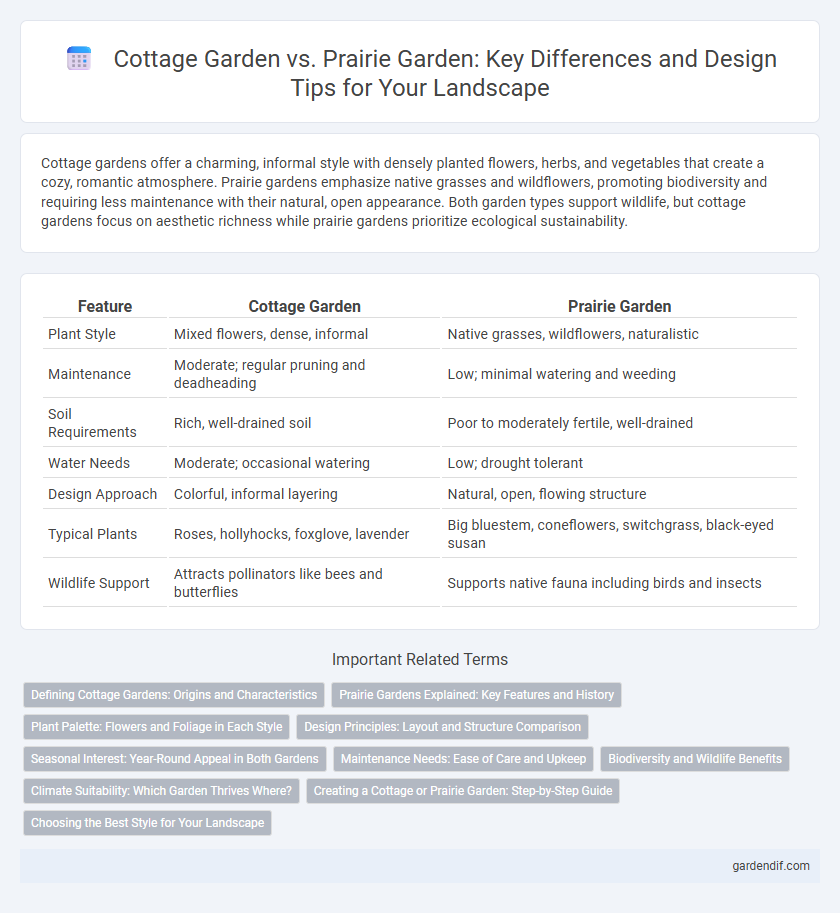
Cottage Garden vs Prairie Garden Illustration
Cottage gardens offer a charming, informal style with densely planted flowers, herbs, and vegetables that create a cozy, romantic atmosphere. Prairie gardens emphasize native grasses and wildflowers, promoting biodiversity and requiring less maintenance with their natural, open appearance. Both garden types support wildlife, but cottage gardens focus on aesthetic richness while prairie gardens prioritize ecological sustainability.
Table of Comparison
| Feature | Cottage Garden | Prairie Garden |
|---|---|---|
| Plant Style | Mixed flowers, dense, informal | Native grasses, wildflowers, naturalistic |
| Maintenance | Moderate; regular pruning and deadheading | Low; minimal watering and weeding |
| Soil Requirements | Rich, well-drained soil | Poor to moderately fertile, well-drained |
| Water Needs | Moderate; occasional watering | Low; drought tolerant |
| Design Approach | Colorful, informal layering | Natural, open, flowing structure |
| Typical Plants | Roses, hollyhocks, foxglove, lavender | Big bluestem, coneflowers, switchgrass, black-eyed susan |
| Wildlife Support | Attracts pollinators like bees and butterflies | Supports native fauna including birds and insects |
Defining Cottage Gardens: Origins and Characteristics
Cottage gardens originated in 16th-century England, characterized by dense, informal plantings of flowers, herbs, and vegetables that create a quaint, charming atmosphere. These gardens prioritize biodiversity with a mix of perennials like hollyhocks, foxgloves, and roses, blending both practicality and aesthetic appeal. The design emphasizes winding paths, rustic structures, and a harmonious, naturalistic layout that contrasts with the open, native grass-focused composition of prairie gardens.
Prairie Gardens Explained: Key Features and History
Prairie gardens mimic native grasslands, featuring tall grasses like big bluestem and switchgrass alongside wildflowers such as black-eyed Susans and coneflowers, promoting biodiversity and supporting pollinators. Originating from the North American prairies, these gardens emphasize drought tolerance, deep-rooted plants, and seasonal interest through naturalistic design. The historical significance of prairie gardens lies in their restoration of native ecosystems, providing habitat for wildlife while reducing maintenance needs compared to traditional lawns or formal gardens.
Plant Palette: Flowers and Foliage in Each Style
Cottage gardens showcase a diverse plant palette with dense clusters of heirloom roses, delphiniums, foxgloves, and lavender, emphasizing colorful, fragrant flowers and lush, textured foliage like mints and scented geraniums. Prairie gardens feature native grasses such as little bluestem and switchgrass combined with hardy perennials like black-eyed Susans, coneflowers, and goldenrods, prioritizing drought-tolerant, ecological diversity and a naturalistic aesthetic. The flower palette in prairie gardens is more subdued and earthy, while cottage gardens highlight vibrant hues and layered planting for a whimsical, romantic effect.
Design Principles: Layout and Structure Comparison
Cottage gardens emphasize informal, dense plantings with winding paths and mixed flower beds creating a charming, intimate layout. Prairie gardens adopt a more naturalistic design featuring open spaces, layered native grasses, and grouped perennials that mimic natural ecosystems. The structural contrast lies in cottage gardens' tightly arranged, vertical layering versus prairie gardens' horizontal spread and emphasis on ecological patterns.
Seasonal Interest: Year-Round Appeal in Both Gardens
Cottage gardens showcase seasonal interest with spring bulbs, summer perennials, and vibrant autumn foliage, offering year-round appeal through diverse plantings like roses, foxgloves, and chrysanthemums. Prairie gardens emphasize native grasses such as big bluestem and switchgrass, alongside wildflowers like coneflowers and black-eyed Susans, maintaining dynamic textures and colors across seasons. Both garden styles prioritize continuous visual interest by combining flowering cycles, foliage changes, and structural elements tailored to their ecological characteristics.
Maintenance Needs: Ease of Care and Upkeep
Cottage gardens require moderate maintenance with regular pruning, weeding, and seasonal planting to preserve their lush, informal appearance, while prairie gardens demand less frequent care due to hardy, drought-tolerant native grasses and perennials that thrive with minimal intervention. The dense planting in cottage gardens can lead to higher pest and disease management, contrasting with prairie gardens' natural resilience and soil enhancement through deep-rooted plants. Homeowners prioritizing ease of care often prefer prairie gardens for their sustainability and low upkeep requirements compared to the more labor-intensive cottage garden style.
Biodiversity and Wildlife Benefits
Cottage gardens promote biodiversity by incorporating diverse, native flowering plants that attract pollinators such as bees, butterflies, and hummingbirds, creating a habitat rich in wildlife. Prairie gardens support a wider range of native grasses and wildflowers, providing essential food and shelter for birds, small mammals, and beneficial insects, enhancing ecosystem stability. Both garden types contribute to ecological balance but prairie gardens tend to offer greater long-term benefits for maintaining regional biodiversity and supporting resilient wildlife populations.
Climate Suitability: Which Garden Thrives Where?
Cottage gardens thrive in temperate climates with moderate rainfall, favoring lush, moisture-retentive soils for their dense, diverse plantings of perennials, herbs, and climbing roses. Prairie gardens are best suited for continental and prairie climates characterized by hot summers, cold winters, and periodic droughts, relying on native grasses and drought-tolerant wildflowers adapted to well-drained, nutrient-poor soils. Selecting a garden style aligned with local climate conditions optimizes plant health and landscape sustainability.
Creating a Cottage or Prairie Garden: Step-by-Step Guide
Creating a cottage garden begins with selecting a diverse mix of perennial flowers, herbs, and climbing plants arranged in informal, dense patterns to evoke a whimsical, romantic feel. Prairie garden design emphasizes native grasses and wildflowers that thrive in well-drained soils and sunny locations, supporting biodiversity while requiring minimal maintenance. Both approaches benefit from soil preparation, strategic plant placement based on sunlight and moisture, and ongoing seasonal care to establish a thriving, sustainable landscape.
Choosing the Best Style for Your Landscape
Cottage gardens emphasize dense, informal plantings with a variety of perennials, herbs, and flowers designed to create a charming, nostalgic atmosphere, ideal for smaller or residential landscapes. Prairie gardens prioritize native grasses and wildflowers, offering a naturalistic style that supports local wildlife and requires lower maintenance, making them suitable for larger or ecologically focused properties. Selecting the best style depends on your landscape size, maintenance preferences, and ecological goals, balancing aesthetic desires with environmental benefits.
Cottage Garden vs Prairie Garden Infographic

 gardendif.com
gardendif.com